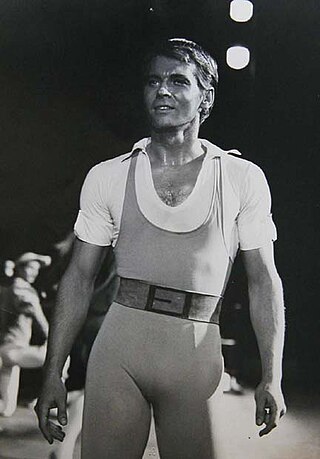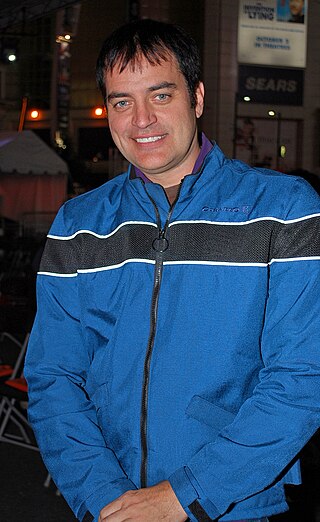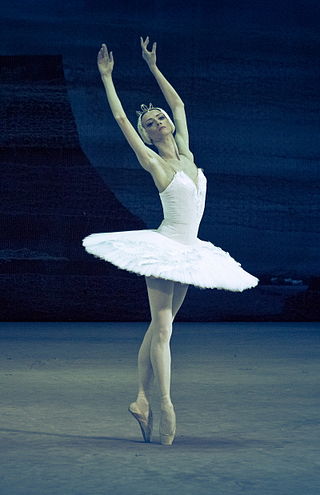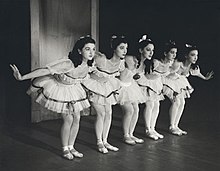Karen Alexandria Kain is a Canadian former ballet dancer and was the Artistic Director of the National Ballet of Canada from 2005 to 2021.

Nancy Elizabeth Oliphant was a co-founder of the National Ballet School of Canada.
Veronica Tennant, is a Canadian producer, director, and filmmaker and a former principal dancer of the National Ballet of Canada. She was born in London, England and moved to Canada with her parents and sister in 1955. Dancing from the age of four, by the age of 18, she became the youngest person ever to enter the National Ballet of Canada.

Celia Franca was a co-founder of The National Ballet of Canada (1951) and its artistic director for 24 years.

David Adams, was a Canadian ballet dancer and a founding member of the National Ballet of Canada.
Kimberly Glasco is a Canadian ballerina. She danced with the National Ballet of Canada until she was dismissed by artistic director James Kudelka. She filed a wrongful dismissal suit against the company which was reportedly settled out of court for $1.6 million.

Rex Howard Harrington, is a Canadian ballet dancer. In 2000, he was made an Officer of the Order of Canada. In 2005, he was inducted into Canada's Walk of Fame. In 2006, he was awarded an honorary doctorate by York University and was made a Fellow of the Royal Society of Canada. He is currently artist-in-residence at the National Ballet of Canada, and is a board member of the Dancer Transition Resource Centre.
Greta Hodgkinson O.Ont is an American-Canadian ballet dancer. She was a Principal dancer with the National Ballet of Canada until she stepped down in 2020. She continues to perform freelance and is Artist-in-Residence of the National Ballet.
James Kudelka, OC, is a Canadian choreographer, dancer, and director. He was the artistic director of the National Ballet of Canada from 1996 to 2005, now serving as the National Ballet's artist in residence.
John Meehan is an Australian ballet director, choreographer, professor, and retired ballet dancer. He was educated at the Anglican Church Grammar School in Brisbane and studied at the Australian Ballet School. Meehan joined the Australian Ballet in 1970 and was promoted to principal dancer in 1974, creating roles in new works by Glen Tetley, John Butler, Garth Welch, Sir Robert Helpmann and Gillian Lynne as well as the role of Count Danilo in Ronald Hynd's The Merry Widow. In 1977 he performed as Guest Artist with American Ballet Theatre (ABT) joining the company as Principal Dancer in the fall of that year. He also danced as guest artist with The Boston Ballet, The National Ballet of Canada and the New York City Ballet.
Canada's National Ballet School, also commonly known as the National Ballet School of Canada, is a classical ballet school located in Toronto, Ontario, Canada. Along with the Royal Winnipeg Ballet School, it is a provider of professional ballet training in Canada. Mavis Staines has been the Artistic Director of the school since 1989.
The Canadian Ballet Festival was an annual event staged in Canada from 1948 to 1954 that brought together various Canadian dance companies to generate public interest in classical dance. Prior to the festivals, it was difficult for professional Canadian dancers to earn a living by practising their art in their own country. When the festivals ended in 1954 after six years, Canadian dancers were able to find paid work in Canadian television practising their art.

Svetlana Aleksandrovna Lunkina is a Russian-Canadian ballerina who is a principal dancer with the National Ballet of Canada.
Anne Ditchburn is a Canadian ballet dancer, choreographer, and film actress headlining films like 1979's Slow Dancing in the Big City as a dancer with a crippling disease, a film directed by Rocky director John G. Avildsen and co-starring Paul Sorvino. She also played the doomed ballet dancer Laurian Summers in the 1983 cult horror film Curtains with John Vernon and Samantha Eggar. She danced in nearly all of her film credits, and earned a Golden Globe nomination for her work in Slow Dancing in the Big City. In her time with the National she choreographed some of its most distinguished pieces of the 1970s, including Mad Shadows and Kisses, while also heading side company Ballet Revue.
Boris Vladimirovich Volkoff, was a Canadian-Russian ballet dancer, director, choreographer and ballet master. After studying dance in Warsaw and Moscow he defected from Russia and eventually settled in Toronto. He created the Boris Volkoff School of Dance which trained ballet dancers, and the Boris Volkoff Ballet Company which is arguably considered the first ballet company in Canada. He gave his dancers and studio to the National Ballet of Canada to raise the profile of Canadian ballet. He regretted this decision and attempted to revive his company which ended in failure. He was appointed as a Member of the Order of Canada in 1973, one year before his death.

Miriam Elaine Adams is a dancer, choreographer, and dance archivist from Toronto. After performing with the National Ballet of Canada, she co-founded 15 Dance Laboratorium with her husband Lawrence Adams. It was the first theatre to present experimental dance in Toronto. In 1983, Miriam and Lawrence launched Encore! Encore! to document the works of six Canadian choreographers from the 1940s and 1950s, and in 1986 they launched a centre for archiving dance and publishing books called Arts Inter-Media Canada/Dance Collection Danse (DCD).

Martine van Hamel is a Dutch choreographer, director, teacher, retired ballerina and former Principal dancer at the National Ballet of Canada and American Ballet Theatre (ABT). She was a gold medalist at the biennial Varna International Ballet Competition, the most prestigious ballet competition in the world, held in Varna, Bulgaria. She is also a recipient of the Prix de Varna, a recognition rarely awarded, for best artistic interpretation in all categories. She was one of the leading classical ballerinas in America.

Guillaume Côté is a Canadian ballet dancer, choreographer, composer and artistic director. He is a principal dancer and a Choreographic Associate at the National Ballet of Canada. In February 2024, he announced that the 2024/2025 season will be his last season before retirement. He has been the Artistic Director of the Festival des Arts de Saint-Sauveur since 2014 and is the Artistic Director of Côté Danse.

Lawrence Vaughan Adams was a Canadian dancer, archivist and publisher. He was a member of the National Ballet of Canada from 1955 to 1960, and also performed with Les Grands Ballets Canadiens and New York's Joffrey Ballet. In 1963, he rejoined the National Ballet of Canada as a soloist and then, principal dancer, leaving the company in 1969.
Elena Lobsanova is a Russian-Canadian ballet dancer. She joined the National Ballet of Canada in 2004 and was promoted to principal dancer in 2015. In 2020, she joined the Miami City Ballet.









